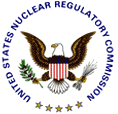| Search Options | ||||
| Index | Site Map | FAQ | Facility Info | Reading Rm | New | Help | Glossary | Contact Us | ||||

| Home > Electronic Reading Room > Document Collections > News Releases > 2008 > 08-004 |
|||||||||
 |
|
||||||||
| No. 08-004 | January 11, 2008 | ||||||||
NRC STAFF ISSUES GENERIC LETTER ON MANAGING |
|||||||||
|
The Nuclear Regulatory Commission staff has asked all U.S. nuclear power plant operators for information on how they protect certain safety systems from buildup of air, nitrogen or other gases that could cause the systems to malfunction. Pockets of gas can damage the pipes, valves and pumps that transport water during a reactor emergency. NRC regulations require plant operators to prevent gases from accumulating beyond the point where safety systems could be compromised. “U.S. plants are operating safely, but we’ve seen a steady recurrence of gas accumulation affecting safety systems over the past 10 years,” said Bill Ruland, Director of the Division of Safety Systems in the NRC’s Office of Nuclear Reactor Regulation. “We’re asking the plants to describe and verify what they’ve been doing to meet our regulations, and we’ll examine their answers to see if we need to take more action.” The NRC’s “Generic Letter” asks plant operators to evaluate three basic system types – emergency core cooling, decay heat removal, and containment spray – to determine how their design, testing and corrective action programs address gas buildup. The agency asks plant operators to provide three types of information from the evaluations:
Licensees have nine months to respond. If a plant operator feels it cannot meet this date, the operator has three months to describe the actions it will take and why it believes those actions are acceptable. A draft letter was published for comment in the Federal Register, and responses to public comments have been incorporated into the final document. The letter will be available electronically on the NRC’s Web site at this address: http://www.nrc.gov/reading-rm/doc-collections/gen-comm/gen-letters/2008/index.html . |
|||||||||
|
NRC news releases are available through a free listserv subscription at the following Web address: http://www.nrc.gov/public-involve/listserver.html. The NRC Home Page at www.nrc.gov also offers a Subscribe to News link in the News & Information menu. E-mail notifications are sent to subscribers when news releases are posted to NRC's Web Site. |
|||||||||
|
Privacy Policy |
Site Disclaimer |